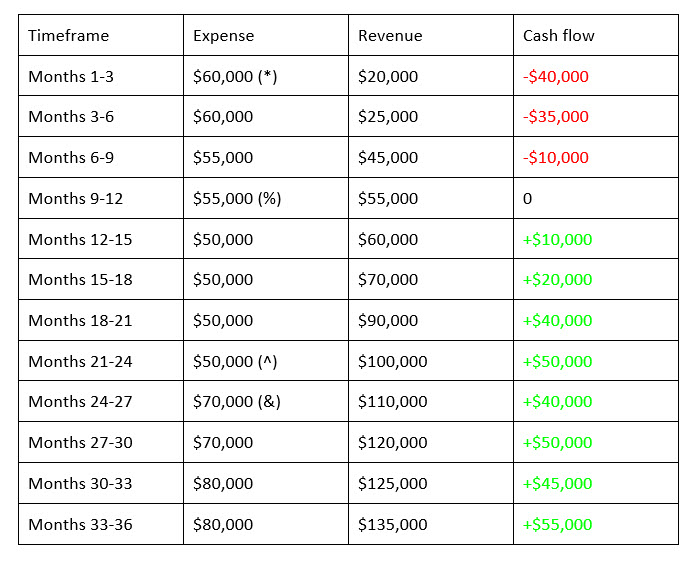
Part two of the Practice Launchpad series, curated by Erich H. Mattei, MBA, president of Akrinos. Each article will examine a different aspect of making a new practice a success. Click HERE to read part one.
By Aaron Neufeld, OD, FAAO
May 25, 2022
When you want to launch a new business endeavor, such as offering new or expanded services, a financial forecast and feasibility analysis can tell you how much it will cost you, and how much in revenues you will have to generate monthly to break even and then to profit. Here is how I use financial forecasts and feasibility analyses in my practice, including how I am using this tool to launch a satellite specialty contact lens practice.
What Is a Financial Forecast & Feasibility Analysis
A financial forecast/feasibility analysis guides you in taking a look at initial capital investments and cash flow projections for either the purchase of an existing practice or cold-starting a new practice. The purpose of the analysis is for the prospective owner to get an idea of the initial investment/financing needed to get their practice off the ground. The owner then has a sense of how the practice must perform to operate at a profit level. The analysis will directly play into how the prospective owner allocates resources.
The analysis is especially essential to new practice owners because of two reasons:
1) It allows them to have a systematic approach to achieving profitability.
2) It illustrates this approach with actual financial metrics to make the process more concrete, rather than theoretical.
Step One: How Much Capital Do I Need?
Step one is understanding the necessary initial capital investment for a practice. This should take all start-up (or acquisition) costs into account and also include working capital needed for the next 3-6 months. Start-up costs include the following:
● Lease expenses or building purchase
● Build-out expenses
● Equipment
● Staffing expenses (first 3-6 months)
● Inventory (frames, lenses, contact lenses)
● Website/Marketing/Online presence
● Licensing/Credentialing/Insurance
Acquisition costs most likely fall under an assets purchase deal, but will contain all of the above, plus patient records and associated goodwill.
Break Down Specific Costs & Revenue Projections
● Revenue & Expense Modeling – weekly revenue cycle modeling to demonstrate necessary steps to achieve positive cash flow.
● Thirty-six Month Revenue Forecast – a projection of potential revenue based on established revenue and expense model.
● Three-Year Snapshot – a look into the future and practice financial health standing at Year 3.
● Feasibility Analysis – taking a step back to see how realistic the previous three projections are based on our business model, patient demographics, extraneous factors, etc.
How I Am Using Financial Forecasting & Feasibility Analysis to Launch Specialty CL Practice
Here is the financial forecast and feasibility analysis I conducted for a specialty contact lens practice (satellite clinic) I will be starting. I have adjusted the numbers to be easier to follow. This clinic will be by appointment-only with 2-3 doctor days per week.
These numbers are projections for use in data modeling.
● Initial Capital Investment – $500,000
i) Building purchase down payment – $300,000
ii) Single lane build-out – $50,000
iii) Equipment – $50,000
iv) Working Capital – $50,000
v) Inventory – $10,000
vi) Website/Marketing/Online presence – $7,000
vii) Licensing/credentialing/insurance – $3,000
● Revenue & Expense Modeling
i) Expense
ii) Building mortgage – $2,000
iii) Staffing – $5,000
iv) Doctor Salary – $5,000
v) Marketing – $1,000
vi) COGs – ~$3,000
vii) Utilities – $500
**Total – $16,500 PER MONTH
Now that we have total expenses for a month, we can calculate the revenue needed to break even. Anything above the amount yields positive cash flow, anything below yields negative cash flow.
● Revenue – needed $16,500 PER MONTH
Assuming our specialty contact lens practice has an average fit charge of $1,000 and materials sales of $500 per patient, we need 11 patients per month to break even:
1) Professional Fees – $11,000
2) Materials – $5,500
● 36-Month Revenue Forecast
i) This is a cold start, so we know that initially we will probably have less than our breakeven threshold.
ii) Since we are a specialty practice, our new patient acquisition will occur primarily through referral and online marketing.
iii) To build our patient base, we will need to spend more on marketing. This has a twofold negative effect on instantaneous cash flow: 1) higher expense, 2) time away from the office for the doctor to visit referral sources.
iv) Thus, we have this 36-month forecast (simplified and broken up by quarter – so we are multiplying our values from our Revenue and Expense Modeling by three:
 Note that a three-month budget for expenses based on revenue and expense modeling is ~$50,000, however our first 6-12 months have significantly higher marketing costs to acquire patients to start the initial practice build (*). From our 36-month revenue forecast, we can see that breakeven monthly cash flow occurs around Q4 of our first year (months 9-12) (%). From a purely numeric standpoint, our practice becomes profitable somewhere in Q4 of year 2 (Months 21-24)(^) .
Note that a three-month budget for expenses based on revenue and expense modeling is ~$50,000, however our first 6-12 months have significantly higher marketing costs to acquire patients to start the initial practice build (*). From our 36-month revenue forecast, we can see that breakeven monthly cash flow occurs around Q4 of our first year (months 9-12) (%). From a purely numeric standpoint, our practice becomes profitable somewhere in Q4 of year 2 (Months 21-24)(^) .
Since we are focused on growth, at the start of Year 3 (Months 24-27), rather than pocketing our profits, we reinvest them into the business for marketing and better equipment. This allows further growth, which leads to more positive cash flow and profitability.
● 3-Year Snapshot
Based on our model, our practice is fairly profitable at the three-year snapshot. At this point, the owner of the practice must make key decisions. Will profits be further invested in the practice to continue growth? Will they be used to hire another doctor and build out another lane? Will they be used to pay down debt? Or will the owner start taking out distributions to supplement the meager salary they were taking?
With a three-year snapshot, the owner is thinking about all these tough questions from day one and is well prepared when the time comes.
● Feasibility Analysis
While our 36-month revenue forecast is great with profitability showing two years in, we need to take into account that this is merely a model. Many factors can come into play to completely disrupt the data – staffing issues (a huge problem for everyone right now), inability to acquire patients, rise in COGS, etc. Therefore, we need to decide how feasible our overall forecast is by looking at every external hurdle possible and then creating proposed solutions for each of these hurdles.
Bottom Line: Financial Forecasts & Feasibility Analyses Tell You How to Profitably Grow
Financial forecasts and feasibility analyses are vital for new owners to create realistic projections, which, in turn, determine the business’s financial success, and the owner’s financial success too. Owners of existing practices should also run these analyses to find areas where they can improve, as well as areas with potential growth. A yearly financial forecast and feasibility analysis is ideal.
Other Articles to Explore
As my private practice was an existing practice for a long time before I purchased it, I found there were many areas where I was able to “lean out” by conducting these analyses.
Having this information allowed us to lower expenses, which then increased our cash flow. Additionally, running the numbers allowed me to make informed decisions on big purchases for the practice, including purchasing the building housing my practice and making technology investments. Having the right financial information gives you what you need to make the most profitable decisions for your practice.
 Aaron Neufeld, OD, FAAO, is the owner of Los Altos Optometric Group in Los Altos, Calif., and co-founder of ODs on Finance. To contact: aneufeldod@gmail.com
Aaron Neufeld, OD, FAAO, is the owner of Los Altos Optometric Group in Los Altos, Calif., and co-founder of ODs on Finance. To contact: aneufeldod@gmail.com

























